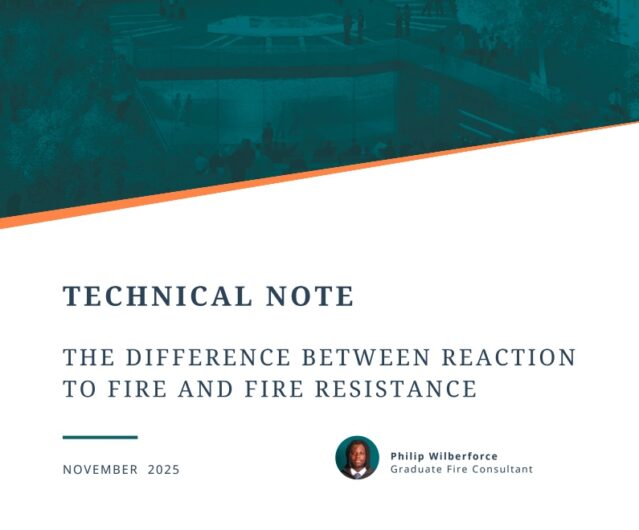Clarity around fire performance is vital in building design. Two terms that are often confused are ‘fire resistance’ and ‘reaction to fire’. While they sound similar, they refer to very different properties, are tested under separate standards, and have distinct roles in a fire safety strategy.
At Cahill Design Consultants, our fire engineering team regularly sees these terms used interchangeably. Misuse can lead to inaccurate specification, regulatory setbacks, and even gaps in fire protection. This guide sets out what each term means and why it’s important to make the distinction.
Fire resistance
Fire resistance addresses containment. It describes how long a building element (such as a wall, floor, ceiling, or fire door) can inhibit the passage of fire, heat and smoke. This is classified under the BS EN 13501-2.
In practice, fire resistance ensures that key structural elements remain stable during a fire, allowing time for safe evacuation.
Reaction to fire
Reaction to fire assesses behaviour. It describes how a material responds when exposed to flames paying attention to whether it:
- Contributes to growth
- Produces smoke
- Creates flaming droplets
This performance is classified under BS EN 13501-1. In summary, reaction to fire assesses flammability, while fire resistance deals with containment.
Why the difference matters
In practice, fire resistance and reaction to fire often need to be considered side by side. Looking at just one in isolation can give a false sense of safety.
Take an external wall, for example. The wall build-up might be designed to provide 60 minutes of fire resistance, meaning it can hold back fire and protect the structure for a defined period. But if the cladding, insulation, or membrane used on the outside has a poor reaction to fire rating, those materials may ignite quickly and contribute to the fire’s growth on the surface. Even though the wall is structurally fire-resistant, combustible external components can still allow fire to spread across the façade, undermining the overall fire safety strategy.
This scenario demonstrates why confusing the two terms can cause problems in specification and compliance. A material may have a strong reaction to fire rating but still needs to form part of a system with adequate fire resistance. Equally, a wall with good fire resistance may not be enough if the finish contributes to fire growth.
Looking at both measures together gives a more complete picture of how a building will perform in a fire, helping design teams make safer, more reliable and compliant choices.
Our role as fire engineering consultants
At Cahill Design Consultants, we help clients interpret fire performance requirements and apply them correctly to their projects. Our team works alongside architects, engineers and contractors to unravel compliance and support safe, practical design.
For a deeper dive, you can download our full technical note here, which includes examples, classifications, and practical guidance for specifiers and design teams.
If you would like advice on fire safety strategy or support with specification, get in touch with our team on 01206 809598 (Colchester) or 0203 950 9082 (London), or use our online enquiry form.





